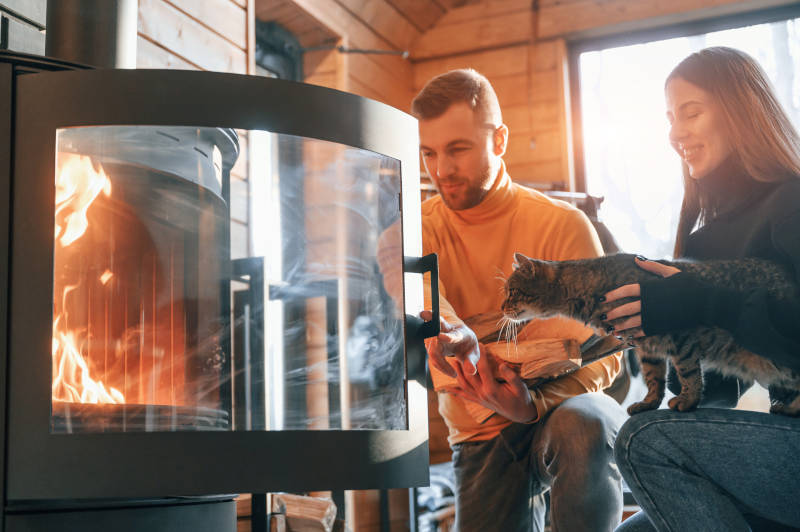There’s nothing quite like the warmth and charm of a wood stove on a chilly evening. But with great coziness comes great responsibility—keeping your wood stove clean is crucial for both efficiency and safety. A dirty stove can lead to poor performance, increased fire risks, and even health hazards from creosote buildup. Whether you’re a seasoned wood stove user or a newbie, this guide will walk you through everything you need to know about wood stove cleaning. Let’s keep those fires burning bright and safe!
Why Cleaning Your Wood Stove is a Big Deal
Your wood stove isn’t just a source of heat—it’s a system that requires regular maintenance to function properly. Here’s why cleaning is so important:
- Prevent chimney fires: Creosote, a sticky byproduct of burning wood, can build up in your stovepipe and chimney. If it ignites, it can cause a dangerous chimney fire.
- Improve efficiency: A clean stove burns more efficiently, saving you money on firewood and keeping your home warmer.
- Protect your health: A poorly maintained stove can release harmful gases like carbon monoxide into your home.
- Extend the life of your stove: Regular cleaning prevents corrosion and wear, helping your stove last for years.
How Often Should You Clean Your Wood Stove?
The frequency of cleaning depends on how often you use your stove, but here’s a general rule of thumb:
- Daily: Remove ash from the firebox to maintain proper airflow.
- Weekly: Check for soot and creosote buildup in the stovepipe and around the door gaskets.
- Seasonally: Deep clean the entire stove, including the chimney, before and after the heating season.
- Annually: Have a professional inspect and clean your chimney to ensure it’s in top condition.
Step-by-Step Guide to Cleaning Your Wood Stove
Ready to roll up your sleeves? Here’s how to clean your wood stove like a pro:
1. Gather Your Supplies
You’ll need:
- A metal ash bucket with a lid
- A shovel or ash scoop
- A stiff-bristle brush or creosote remover
- A vacuum designed for ash (optional)
- Glass cleaner (for stoves with glass doors)
- A damp cloth or sponge
- Protective gloves and a mask
2. Remove the Ash
- Let the stove cool completely.
- Open the door and use a shovel or scoop to transfer the ash into a metal ash bucket. Never use a plastic bag or container—ashes can stay hot for days and pose a fire risk.
- Leave a small layer of ash (about an inch) to help insulate the next fire.
3. Clean the Interior
- Use a stiff-bristle brush to scrub the interior walls and remove soot and creosote buildup.
- If your stove has a catalytic combustor, check the manufacturer’s instructions for cleaning it properly.
4. Tackle the Glass Door
- Mix a solution of water and vinegar or use a specialized stove glass cleaner.
- Gently scrub the glass with a non-abrasive cloth or sponge to remove soot and stains.
- Avoid using harsh chemicals or abrasive tools that could scratch the glass.
5. Inspect and Clean the Stovepipe
- Remove the stovepipe (if possible) and use a creosote remover or brush to clean the inside.
- Check for cracks, rust, or other damage that could affect performance.
6. Wipe Down the Exterior
- Use a damp cloth to wipe down the outside of the stove, removing dust and soot.
- Avoid using water or cleaning products on the stove’s painted surfaces, as this can cause rust or damage the finish.
Pro Tips for Maintaining Your Wood Stove
- Burn dry, seasoned wood: Wet or green wood produces more creosote and burns less efficiently.
- Use a creosote remover: Adding a creosote-busting product to your fire can help reduce buildup in the chimney.
- Check the gaskets: Inspect the door gaskets regularly and replace them if they’re worn or damaged.
- Install a chimney cap: This keeps out rain, debris, and critters that could block your chimney.
When to Call a Professional
While regular cleaning can be done yourself, some tasks are best left to the experts. Call a professional chimney sweep if:
- You notice a strong, smoky smell even when the stove is burning properly.
- There’s visible creosote buildup in the chimney (it looks shiny and tar-like).
- You haven’t had your chimney inspected in over a year.
The Bottom Line: A Clean Stove is a Happy Stove
Your wood stove is more than just a source of heat—it’s a centerpiece of comfort and warmth in your home. By keeping it clean and well-maintained, you’ll not only enjoy a safer and more efficient fire but also extend the life of your stove for years to come. So grab your tools, put on your gloves, and show your wood stove some love. After all, a little cleaning goes a long way in keeping those fires burning bright!
Ready to get started? Share your favorite wood stove cleaning tips in the comments below—or let us know if you’ve got any questions. Stay warm and stay safe! 🔥✨

